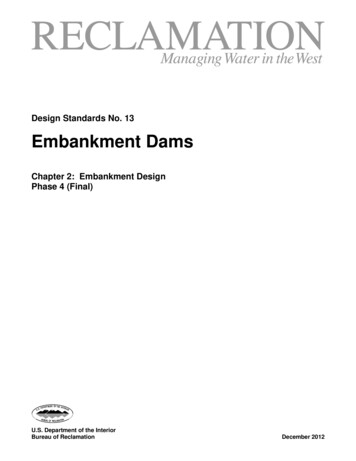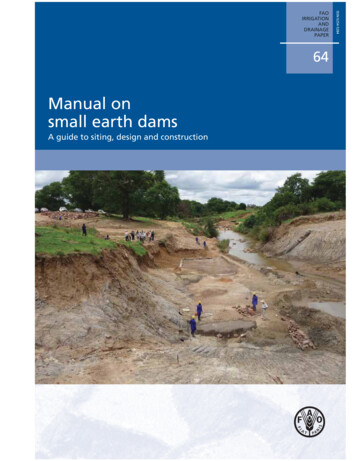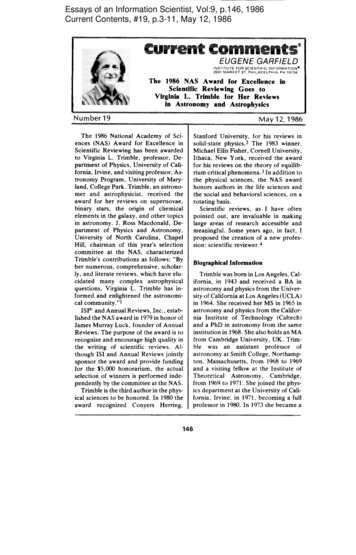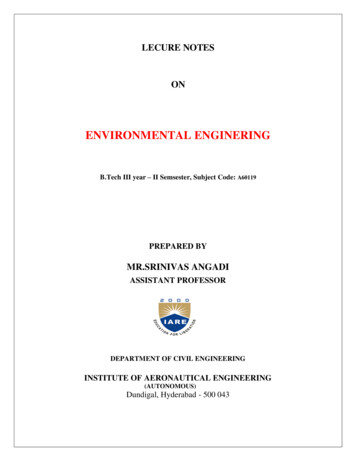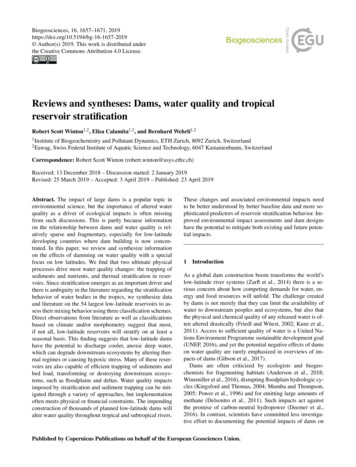
Transcription
Biogeosciences, 16, 1657–1671, 2019https://doi.org/10.5194/bg-16-1657-2019 Author(s) 2019. This work is distributed underthe Creative Commons Attribution 4.0 License.Reviews and syntheses: Dams, water quality and tropicalreservoir stratificationRobert Scott Winton1,2 , Elisa Calamita1,2 , and Bernhard Wehrli1,21 Institute2 Eawag,of Biogeochemistry and Pollutant Dynamics, ETH Zurich, 8092 Zurich, SwitzerlandSwiss Federal Institute of Aquatic Science and Technology, 6047 Kastanienbaum, SwitzerlandCorrespondence: Robert Scott Winton (robert.winton@usys.ethz.ch)Received: 13 December 2018 – Discussion started: 2 January 2019Revised: 25 March 2019 – Accepted: 3 April 2019 – Published: 23 April 2019Abstract. The impact of large dams is a popular topic inenvironmental science, but the importance of altered waterquality as a driver of ecological impacts is often missingfrom such discussions. This is partly because informationon the relationship between dams and water quality is relatively sparse and fragmentary, especially for low-latitudedeveloping countries where dam building is now concentrated. In this paper, we review and synthesize informationon the effects of damming on water quality with a specialfocus on low latitudes. We find that two ultimate physicalprocesses drive most water quality changes: the trapping ofsediments and nutrients, and thermal stratification in reservoirs. Since stratification emerges as an important driver andthere is ambiguity in the literature regarding the stratificationbehavior of water bodies in the tropics, we synthesize dataand literature on the 54 largest low-latitude reservoirs to assess their mixing behavior using three classification schemes.Direct observations from literature as well as classificationsbased on climate and/or morphometry suggest that most,if not all, low-latitude reservoirs will stratify on at least aseasonal basis. This finding suggests that low-latitude damshave the potential to discharge cooler, anoxic deep water,which can degrade downstream ecosystems by altering thermal regimes or causing hypoxic stress. Many of these reservoirs are also capable of efficient trapping of sediments andbed load, transforming or destroying downstream ecosystems, such as floodplains and deltas. Water quality impactsimposed by stratification and sediment trapping can be mitigated through a variety of approaches, but implementationoften meets physical or financial constraints. The impendingconstruction of thousands of planned low-latitude dams willalter water quality throughout tropical and subtropical rivers.These changes and associated environmental impacts needto be better understood by better baseline data and more sophisticated predictors of reservoir stratification behavior. Improved environmental impact assessments and dam designshave the potential to mitigate both existing and future potential impacts.1IntroductionAs a global dam construction boom transforms the world’slow-latitude river systems (Zarfl et al., 2014) there is a serious concern about how competing demands for water, energy and food resources will unfold. The challenge createdby dams is not merely that they can limit the availability ofwater to downstream peoples and ecosystems, but also thatthe physical and chemical quality of any released water is often altered drastically (Friedl and Wüest, 2002; Kunz et al.,2011). Access to sufficient quality of water is a United Nations Environment Programme sustainable development goal(UNEP, 2016), and yet the potential negative effects of damson water quality are rarely emphasized in overviews of impacts of dams (Gibson et al., 2017).Dams are often criticized by ecologists and biogeochemists for fragmenting habitats (Anderson et al., 2018;Winemiller et al., 2016), disrupting floodplain hydrologic cycles (Kingsford and Thomas, 2004; Mumba and Thompson,2005; Power et al., 1996) and for emitting large amounts ofmethane (Delsontro et al., 2011). Such impacts act againstthe promise of carbon-neutral hydropower (Deemer et al.,2016). In contrast, scientists have committed less investigative effort to documenting the potential impacts of dams onPublished by Copernicus Publications on behalf of the European Geosciences Union.
1658R. S. Winton et al.: Dams, water quality and tropical reservoir stratificationwater quality. In cases where investigators have synthesizedknowledge of water quality impacts (Friedl and Wüest, 2002;Nilsson and Renofalt, 2008; Petts, 1986), the conclusions areinevitably biased towards mid/high latitudes where the bulkof case studies and mitigation efforts have occurred.While there is much to be learned from more thoroughly studied high-latitude rivers, given the fundamentalrole played by climate in river and lake functioning, it is important to consider how the low-latitude reservoirs may behave differently. For example, the process of reservoir stratification, which plays a crucial role in driving downstreamwater quality impacts, is governed to a large degree by local climate. Additionally, tropical aquatic systems are moreprone to suffer from oxygen depletion because of lower oxygen solubility and faster organic matter decomposition athigher temperatures (Lewis, 2000). Latitude also plays animportant role in considering ecological or physiological responses to altered water quality. Studies focused on coldwater fish species may have little applicability to warmerrivers in the subtropics and tropics.Low-latitude river systems are experiencing a high rateof new impacts from very large dam projects. A review ofthe construction history of very large reservoirs of at least10 km3 below 35 latitude reveals that few projects werelaunched between 1987 and 2000, but in the recent decade(2001–2011) low-latitude mega-reservoirs have appeared ata rate of one new project per year (Fig. 1). Given that ongoing and proposed major dam projects are concentrated at lowlatitudes (Zarfl et al., 2014), a specific review of water qualityimpacts of dams and the extent to which they are understoodand manageable in tropical biomes is needed.Large dams exert impacts across many dimension; butin this review, we largely ignore the important, but wellcovered, impacts of altered hydrologic regimes. Instead, wefocus on water quality, while acknowledging that flow andwater quality issues are often inextricable. We also disregardthe important issue of habitat fragmentation and the manyacute impacts on ecosystems and local human populationsarising from dam construction activities (i.e., displacementand habitat loss due to inundation). These important topicshave been recently reviewed elsewhere (e.g., Winemiller etal., 2016; Anderson et al., 2018).In order to understand the severity and ubiquity of water quality impacts associated with dams, it is necessary tounderstand the process of lake stratification, which occursbecause density gradients within lake water formed by solar heating of the water surface prevent efficient mixing. Byisolating deep reservoir water from surface oxygen, stratification facilitates the development of low-oxygen conditionsand a suite of chemical changes that can be passed downstream. To address the outstanding question of whether lowlatitude reservoirs are likely to stratify and experience associated chemical water quality changes, we devote a sectionof this study to predicting reservoir stratification. This analysis includes the largest low-latitude reservoirs and is focusedBiogeosciences, 16, 1657–1671, 2019Figure 1. Construction history of the world’s 54 largest reservoirslocated below 35 latitude. Project year of completion data arefrom the International Commission on Large Dams (https://www.icold-cigb.net/, last access: 1 November 2018). Project start data areapproximate ( 1 year) and based on either gray literature sourceor for some more recent dams, i.e., visual inspection of GoogleEarth satellite imagery. Grand Ethiopian Renaissance abbreviatedas GER. Volume in map legend is in cubic kilometers.on physical and chemical processes within the reservoirs thatmay affect downstream water quality.Finally, we review off-the-shelf efforts to manage or mitigate undesired chemical and ecological effects of dams related to water quality. The management of dam operationsto minimize downstream ecological impacts follows the concept of environmental flows (eflows). The primary goal ofeflows is to mimic natural hydrologic cycles for downstreamecosystems, which are otherwise impaired by conventionaldam-altered hydrology of diminished flood peaks and higherminimum flows. Although restoring hydrology is vitally important to ecological functioning, it does not necessarilysolve water quality impacts, which often require differenttypes of management actions. Rather than duplicate the recent eflow reconceptualizations (e.g., Tharme, 2003; Richter,2009; Olden and Naiman, 2010; O’Keeffe, 2018), we focusour review on dam management efforts that specifically tarwww.biogeosciences.net/16/1657/2019/
R. S. Winton et al.: Dams, water quality and tropical reservoir stratification1659are not well understood. Collecting the reservoir depth profiles necessary to generate this key information may be moredifficult than simply analyzing water chemistry below dams.Dam tail waters with low oxygen or reduced compounds,such as hydrogen sulfide or dissolved methane, are likely tostem from discharged deep water of a stratified reservoir.2.1.1Figure 2. Conceptual summary of the physical and chemical waterquality effects of dams and how they affect aquatic ecology.get water quality, which includes both eflow and non-eflowactions.2Impacts of dams on river water qualityThe act of damming and impounding a river imposes a fundamental physical change upon the river continuum. The rivervelocity slows as it approaches the dam wall and the createdreservoir becomes a lacustrine system. The physical changeof damming leads to chemical changes within the reservoir,which alters the physical and chemical water quality, whichin turn leads to ecological impacts on downstream rivers andassociated wetlands. The best-documented physical, chemical and ecological effects of damming on water quality aresummarized in Fig. 2 and described in detail in this section. In each subsection, we begin with a general overviewand then specifically consider the available evidence for lowlatitude systems.2.1Stratification-related effectsStratification, i.e., the separation of reservoir waters into stable layers of differing densities, has important consequencesfor river water downstream of dams. A key to understandingthe impacts of dams on river water quality is a precise understanding of the depth of the reservoir thermocline/oxyclinerelative to spillway or turbine intakes. At many high-headstorage hydropower dams, the turbine intakes are more than10–20 m deep to preserve generation capacity even under extreme drought conditions. For example, Kariba Dam’s intakes pull water from 20 to 25 m below the typical level ofthe reservoir surface, which roughly coincides with the typical depth of the thermocline. In more turbid tropical reservoirs, thermocline depth can be much shallower, for example at Murum Reservoir in Indonesia where the epilimnion isjust 4 to 6 m thick. Unfortunately, the turbine intake depthsare not typically reported in dam databases. Furthermore, formany reservoirs, especially those in the tropics, the mixingbehavior and therefore the typical depth of the nging thermal regimesEven at low latitudes where seasonal differences are lessthan temperate climates, aquatic ecosystems experience water temperatures that fluctuate according to daily and annualthermal regimes (Olden and Naiman, 2010). Hypolimneticreleases of unseasonably cold water represent alterations to anatural regime. Although the difference between surface anddeep waters in tropical lakes is typically much less than thoseat higher latitudes (Lewis, 1996), the differences are oftenmuch greater than the relatively subtle temperature shifts of3–5 C that have been shown to cause serious impacts (Kinget al., 1998; Preece and Jones, 2002). For example, at 17 south of the Equator, Lake Kariba seasonally reaches a 6 to7 C difference between surface and deep waters (Magadza,2010). The ecological impacts of altered thermal regimeshave been extensively documented across a range of riversystems.Many aquatic insects are highly sensitive to alterations inthermal regime (Eady et al., 2013; Ward and Stanford, 1982),with specific temperature thresholds required for completionof various life cycle phases (Vannote and Sweeney, 1980).Since macroinvertebrates form an important prey base forfish and other larger organisms, there will be cascading effects when insect life cycles are disrupted. Fish have theirown set of thermal requirements, with species often filling specific thermal niches (Coutant, 1987). Altered thermal regimes can shift species distributions and communitycomposition. Development schedules for both fish and insects respond to accumulated daily temperatures above orbelow a threshold, as well as absolute temperatures (Oldenand Naiman, 2010). Fish and insects have both chronic andacute responses to extreme temperatures. A systemic metaanalysis of flow regulation on invertebrates and fish populations by Haxton and Findlay (2008) found that hypolimneticreleases tend to reduce abundance of aquatic species regardless of setting.There exist several case studies from relatively low latitudes suggesting that tropical and subtropical rivers aresusceptible to dam-imposed thermal impacts. The Murraycod has been severely impacted by cold-water pollutionfrom the Dartmouth Dam in Victoria, Australia (Todd etal., 2005) and a variety of native fish species were similarly impacted by the Keepit Dam in New South Wales, Australia (Preece and Jones, 2002). In subtropical China, coldwater dam releases have caused fish spawning to be delayed by several weeks (Zhong and Power, 2015). In tropical Brazil, Sato et al. (2005) tracked disruptions to fish reBiogeosciences, 16, 1657–1671, 2019
1660R. S. Winton et al.: Dams, water quality and tropical reservoir stratificationproductive success 34 km downstream of the Três MariasDam. In tropical South Africa, researchers monitoring downstream temperature-sensitive fish in regulated and unregulated rivers found that warm water flows promoted fishspawning, whereas flows of 3 to 5 C cooler hypolimneticwater forced fish to emigrate (King et al., 1998).2.1.2HypoxiaStratification tends to lead to the deoxygenation of deepreservoir water, because of heterotrophic consumption anda lack of resupply from oxic surface layers. When dam intakes are deeper than the oxycline, hypoxic water can bepassed downstream where it is suspected to cause significant ecological harm. Oxygen concentrations below 3.5 to5 mg L 1 typically trigger escape behavior in higher organisms, whereas only well-adapted organisms survive below2 mg L 1 (Spoor, 1990). A study of 19 dams in the southeastern United States found that 15 routinely released water withless than 5 mg L 1 of dissolved oxygen and 7 released waterwith less than 2 mg L 1 of dissolved oxygen (Higgins andBrock, 1999). Hypoxic releases from these dams often lastedfor months and the hypoxic water was detectable in somecases for dozens of kilometers downstream. Below the HumeDam in Australia, researchers found that oxygen concentrations reached an annual minimum of less than 50 % saturation (well under 5 mg L 1 ), while other un-impacted reference streams always had 100 % oxygen saturation (Walkeret al., 1978). Researchers recently observed similar hypoxicconditions below the Bakun Dam in Malaysia with lessthan 5 mg L 1 recorded for more than 150 km downstream(Wera et al., 2019). Although observations and experimentshave demonstrated the powerful stress that hypoxia exertson many fish species (Coble, 1982; Spoor, 1990), there existfew well-documented field studies of dam-induced hypoxiadisrupting downstream ecosystems. This is partly becauseit can be difficult to distinguish the relative importance ofdissolved oxygen and other correlated chemical and physical parameters (Hill, 1968). Hypolimnetic dam releases containing low oxygen will necessarily also be colder than surface waters and they may contain toxic levels of ammoniaand hydrogen sulfide, so it was not clear which factor wasthe main driver for the loss of benthic macroinvertebrate diversity documented below a dam of the Guadalupe River inTexas (Young et al., 1976).Regardless, regulators in the southern US found the threatof hypoxia to be sufficiently serious to mandate that dam tailwaters maintain a minimum dissolved oxygen content of 4to 6 mg L 1 depending on temperature (Higgins and Brock,1999). These dams in the Tennessee Valley are on the northern fringe of the subtropics ( 35–36 N), but are relativelywarm compared with other reservoirs of the United States.Since oxygen is less soluble in warmer water and gas transfer is driven by the difference between equilibrium and actualconcentrations, it follows that low-oxygen stretches downBiogeosciences, 16, 1657–1671, 2019stream of low-latitude dams will suffer from slower oxygenrecovery.In addition to the direct impact imposed by hypoxic reservoir water when it is discharged downstream, anoxic bottomwaters will also trigger a suite of anaerobic redox processeswithin reservoir sediments that exert additional alterations towater quality. Therefore, anoxia can also exert indirect chemical changes and associated ecological impacts. Here we discuss two particularly prevalent processes: phosphorus remobilization and the generation of soluble reduced compounds.2.1.3Phosphorus remobilization and eutrophicationPhosphorus (P) is an important macronutrient. Its scarcityor limited bioavailability to primary producers often limitsproductivity of aquatic systems. Conversely, the addition ofdissolved P to aquatic ecosystems often stimulates eutrophication, leading to blooms of algae, phytoplankton or floating macrophytes on water surfaces (Carpenter et al., 1998;Smith, 2003). Typically, eutrophication will occur when Pis imported into a system from some external source, but inthe case of lakes and reservoirs internal P loading from sediments can also be important. Most P in the aquatic environment is bound to sediment particles where it is relativelyunavailable for uptake by biota, but anoxic bottom waters oflakes greatly accelerate internal P loading (Nurnberg, 1984).Iron oxide particles are strong absorbers of dissolved ;, butunder anoxic conditions, the iron serves as an electron acceptor and is reduced to a soluble ferrous form. During ironreduction, iron-bound P also becomes soluble and is releasedinto solution where it can build up in hypolimnetic waters.Water rich in P is then either discharged through turbinesor mixed with surface waters during periods of destratification. Therefore, sudden increases in bioavailable P can stimulate algal and other aquatic plant growth in the reservoirepilimnion. Theoretically, discharging of P-rich deep watercould cause similar blooms in downstream river reaches, butwe are not aware of any direct observations of this phenomenon. Typically, nutrient releases in low-latitude contexts are thought of as beneficial to downstream ecosystemsbecause they would counteract the oligotrophication imposedby the dam through sediment trapping (Kunz et al., 2011).Although dams seem to typically lead to overall reductions in downstream nutrient delivery (see “Oligotrophication”, Sect. 2.2.2), the phenomenon of within-reservoir eutrophication because of internal P loading has been extensively documented in lakes and reservoirs worldwide. In theabsence of major anthropogenic nutrient inputs, the eutrophication is typically ephemeral and is abated after several yearsfollowing reservoir creation. A well-known tropical exampleis Lake Kariba, the world’s largest reservoir by volume. Formany years after flooding a 10 % to 15 % of the lake surfacewas covered by Kariba weed (Salvinia molesta), a floatingmacrophyte. Limnologists attributed these blooms to decomposing organic matter and also gradual P release from inunwww.biogeosciences.net/16/1657/2019/
R. S. Winton et al.: Dams, water quality and tropical reservoir stratificationdated soils exposed to an anoxic hypolimnion (Marshall andJunor, 1981).Indeed, some characteristics of tropical lakes seem tomake them especially susceptible to P regeneration from thehypolimnion. The great depth to which mixing occurs (often 50 m or more) during destratification, a product of themild thermal density gradient between surface and deep water, provides more opportunity to transport deep P back tothe surface (Kilham and Kilham, 1990). This has led limnologists to conclude that deep tropical water bodies are moreprone to eutrophication compared with their temperate counterparts (Lewis, 2000). There is of course variability withintropical lakes. Those with larger catchment areas tend toreceive more sediments and nutrients from their inflowingrivers and are also more prone to eutrophication (Straskrabaet al., 1993). These findings together suggest that thermallystratified low-latitude reservoirs run a high risk of experiencing problems of eutrophication because of internal P remobilization.2.1.4Reduced compoundsAnother ecological stressor imposed by hypoxic reservoirwater is a high concentration of reduced compounds, such ashydrogen sulfide (H2 S) and reduced iron, which limit the capacity of the downstream river to cope with pollutants. Sufficient dissolved oxygen is not only necessary for the support of most forms of aquatic life, but it is also essentialto maintaining oxidative self-purification processes withinrivers (Friedl and Wüest, 2002; Petts, 1986). Reduced compounds limit the oxidative capacity of river water by acting as a sink for free dissolved oxygen. The occurrence ofH2 S has been documented in some cases in the tail watersof dams, but the co-occurrence of this stressor with low temperatures and hypoxia make it difficult to attribute the extent to which it causes direct ecological harm (Young et al.,1976). Researchers investigating fish mortality below GreensFerry Dam in Arkansas, USA, found H2 S concentrations of0.1 mg L 1 (Grizzle, 1981), well above the recognized lethalconcentrations of 0.013 to 0.045 mg L 1 of H2 S for fishbased on toxicological studies (Smith et al., 1976). Lethalconcentrations of ammonia for fish are 0.75 to 3.4 mg L 1of unionized NH3 (Thurston et al., 1983), though we are unaware of specific cases where these thresholds have been surpassed because of dams. At the very least, the presence ofreduced compounds at elevated concentrations indicates thatan aquatic system is experiencing severe stresses, which, ifsustained, will be lethal to most macroscopic biota.2.2Sediment trappingDams are highly efficient at retaining sediments (Donald etal., 2015; Garnier et al., 2005; Kunz et al., 2011). As riversapproach reservoirs, the flow velocity slows and loses the potential to slide and bounce along sand and gravel, while ence allows finer sediments to fall out of suspension.Blockage of sediments and coarse material drives two relatedimpact pathways. The first is physical, stemming from theloss of river sediments and bedload that are critical to maintaining the structure of downstream ecosystems (Kondolf,1997). The second is chemical; the loss of sediment-boundnutrients causes oligotrophication of downstream ecosystems including floodplains and deltas (Van Cappellen andMaavara, 2016).2.2.1Altered habitatThe most proximate impact of sediment starvation is the enhancement of erosion downstream of dams from outflowscausing channel incision that can degrade within-channelhabitats for macroinvertebrates and fish (Kondolf, 1997).Impacts also reach adjacent and distant ecosystems suchas floodplains and deltas, which almost universally dependupon rivers to deliver sediments and nutrients to maintain habitat quality and productivity. In addition to sediment/nutrient trapping, dams also dampen seasonal hydrologic peaks, reducing overbank flooding of downstream riverreaches. The combination of these two dam effects leads toa major reduction in the delivery of nutrients to floodplains,which represents a fundamental disruption of the flood pulse,affecting the ecological functioning of floodplains (Junk etal., 1989).River deltas also rely on sediment delivered by floods anddamming has led to widespread loss of delta habitats (Giosanet al., 2014). Sediment delivery to the Mekong Delta has already been halved and could drop to 4 % of baseline if allplanned dams for the catchment are constructed (Kondolfet al., 2014a). Elsewhere in the tropics, dam constructionhas been associated with the loss of mangrove habitat, suchas at the Volta estuary in Ghana (Rubin et al., 1999). Themorphology of the lower Zambezi’s floodplains and deltawere dramatically transformed by reduced sediment loadsassociated with the Cahora Bassa megadam in Mozambique(Davies et al., 2001). With diminished sediment delivery andenhanced erosion from rising sea levels, the future of manycoastal deltas is precarious, as most of the world’s mediumand large deltas are not accumulating sediment fast enoughto stay above water over the coming century (Giosan et al.,2014).2.2.2OligotrophicationAlthough the densely populated and industrialized watersheds of the world typically suffer from eutrophication, daminduced oligotrophication, through sediment and nutrienttrapping, can also severely alter the ecological functioning ofrivers and their floodplains, deltas and coastal waters. Globally, 12 % to 17 % of global river phosphorus load is trappedbehind dams (Maavara et al., 2015); but in specific locations, trapping efficiency can be greater than 90 %, such asBiogeosciences, 16, 1657–1671, 2019
1662R. S. Winton et al.: Dams, water quality and tropical reservoir stratificationat Kariba Dam on the Zambezi River (Kunz et al., 2011)and the Aswan Dam on the Nile (Giosan et al., 2014). Suchextreme losses of sediments and nutrients can cause seriousacute impacts to downstream ecosystems, though examplesare relatively scarce because predam baseline data are notoften available.Most of the best-documented examples of impacts stemming from oligotrophication are from temperate catchmentswith important and carefully monitored fisheries. For example damming led to the collapse of a valuable salmon fisheryin Kootenay Lake, British Columbia, Canada, through oligotrophication (Ashley et al., 1997). The fishery was eventually restored through artificial nutrient additions. Oligotrophication may impose similar ecological impacts in tropicalcontexts, such as in southern Brazil where an increase inwater clarity following the closure of the Eng. Sérgio MottaDam (Porto Primavera Dam) was associated with a shift infish communities (Granzotti et al., 2018). Impacts have beenperhaps most dramatic in the eastern Mediterranean following the closure of the Aswan Dam. The Lake Nasser reservoir, following its closure in 1969, began capturing the totality of the Nile’s famously sediment-rich floodwaters, including some 130 million tons of sediment that had previouslyreached the Mediterranean Sea. In the subsequent years therewas a 95 % drop in phytoplankton biomass and an 80 % dropin fish landings (Halim, 1991). With dams driving rivers toward oligotrophy, and land-use changes such as deforestationand agricultural intensification, causing eutrophication, globally most rivers face some significant change to trophic state.2.32.2.33Elemental ratiosThe attention to phosphorus and nitrogen can obscure the importance of other nutrients and their ratios. The element silicon (Si), which is also efficiently sequestered within reservoirs, is an essential nutrient for certain types of phytoplankton. The simultaneous eutrophication and damming ofmany watersheds has led to decreases in Si to nitrogen ratios, which tends to favor nonsiliceous species over diatoms(Turner et al., 1998). In the river Danube efficient trapping of Si in reservoirs over several decades led to a shiftin Black Sea phytoplankton communities (Humborg et al.,1997), coinciding with a crash in an important and productive fishery (Tolmazin, 1985). Turner et al. (1998) documenta similar phenomenon at lower latitude in the MississippiDelta. Decreases in Si loading led to a drop in the abundance of copepods and diatoms relative to the total mesozooplankton population in the Gulf of Mexico (Turner et al.,1998). These community shifts may have important implications for coastal and estuarine fish communities and theemergence of potential harmful algal blooms.Biogeosciences, 16, 1657–1671, 2019Reversibility and propagation of impactsOne way to think of the scope of dam impacts on water quality is in terms of how reversible perturbations to each variablemay be. Sediment trapped by a dam may be irreversibly lostfrom a river and even unregulated downstream tributaries areunlikely to compensate. Temperature and oxygen impacts ofdams, in contrast, will happen gradually through exchangewith the atmosphere as the river flows. The speed of recovery will depend upon river depth, surface areas, turbulenceand other factors that may provide input to predictive models (Langbein and Durum, 1967). Field data from subtropicalAustralia and tropical Malaysia suggest that, in practice, hypoxia can extend to dozens or hundreds of kilometers downstream of dam walls (Walker et al., 1978; Wera et al., 2019).Where reaeration measures are incorporated into dam operations, hypoxia can be mitigated immediately or within a fewkilometers, as was the case in Tennessee, USA (Higgins andBrock, 1999). A study in Colorado, USA, found that thermaleffects could be detected for hundreds of kilometers
Reviews and syntheses: Dams, water quality and tropical reservoir stratification . seasonal basis. This finding suggests that low-latitude dams . As a global dam construction boom transforms the world’s low-lati


